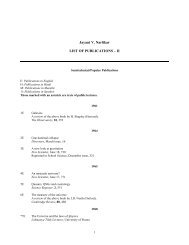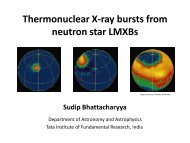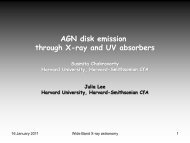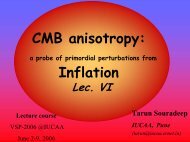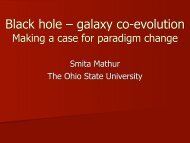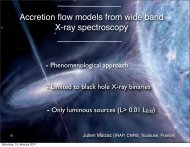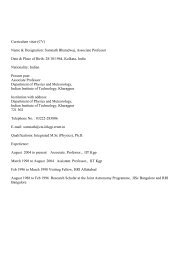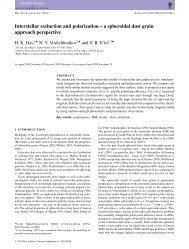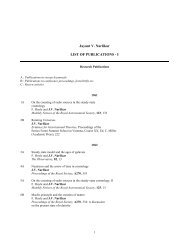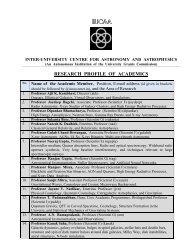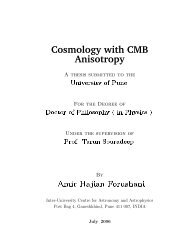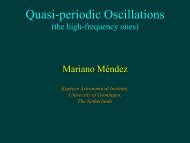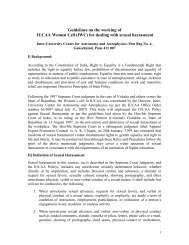Non-spherical gravitational collapse of strange quark matter - iucaa
Non-spherical gravitational collapse of strange quark matter - iucaa
Non-spherical gravitational collapse of strange quark matter - iucaa
You also want an ePaper? Increase the reach of your titles
YUMPU automatically turns print PDFs into web optimized ePapers that Google loves.
<strong>Non</strong>-<strong>spherical</strong> <strong>gravitational</strong> <strong>collapse</strong> <strong>of</strong> <strong>strange</strong><strong>quark</strong> <strong>matter</strong>K D Patil ∗Department <strong>of</strong> Mathematics, B D College <strong>of</strong> Engineering,Sewagram,Wardha (MS), IndiaS S ZadeDepartment <strong>of</strong> Mathematics, J B College <strong>of</strong> Science,Wardha (MS), IndiaA N MohodDepartment <strong>of</strong> Mathematics, S S S K R Innani Mahavidyalaya,Karanja(Lad) (MS), IndiaAbstractWe study the non-<strong>spherical</strong> <strong>gravitational</strong> <strong>collapse</strong> <strong>of</strong> the <strong>strange</strong> <strong>quark</strong> nullfluid. The interesting feature which emerges is that the non-<strong>spherical</strong> <strong>collapse</strong><strong>of</strong> charged <strong>strange</strong> <strong>quark</strong> <strong>matter</strong> leads to a naked singularity whereas the <strong>gravitational</strong><strong>collapse</strong> <strong>of</strong> neutral <strong>quark</strong> <strong>matter</strong> proceeds to form a black hole. Inthe present brief report we extend the earlier work <strong>of</strong> T.Harko and K.S.Chengto the non-<strong>spherical</strong> case.Key words. Gravitational <strong>collapse</strong>; naked singularity; black hole; <strong>strange</strong> <strong>quark</strong><strong>matter</strong>.PACS Nos 04.20.Dw, 04.20.Cv, 04.70.Bw∗ e-mail kishordpatil@yahoo.com1
1. IntroductionIn past thirty years, there have been extensive studies on <strong>gravitational</strong> <strong>collapse</strong> inorder to investigate the nature <strong>of</strong> the singularities. The study <strong>of</strong> <strong>gravitational</strong> <strong>collapse</strong><strong>of</strong> <strong>spherical</strong>ly symmetric spacetimes led to many examples <strong>of</strong> naked singularities [1-10]. Most <strong>of</strong> these papers concentrate on the aim to find light rays emanated fromthe central singularity and escaping the Schwarzschildian trapped surface at leastlocally. In order to study the nature <strong>of</strong> the singularity, global behaviour <strong>of</strong> radialnull geodesics must be studied in full generality.For more than thirty years, cosmic censorship hypothesis (CCH) has been one<strong>of</strong> the most active areas <strong>of</strong> research in general relativity. CCH was proposed byR.Penrose[11], which states that singularities formed in <strong>gravitational</strong> <strong>collapse</strong> <strong>of</strong>physically reasonable <strong>matter</strong> can not be observed. There are two versions <strong>of</strong> thishypothesis. The weak CCH states that all singularities formed in <strong>gravitational</strong> <strong>collapse</strong>are hidden behind the event horizon <strong>of</strong> the gravity and are invisible to thedistant observer from infinity. On the other hand, the strong CCH asserts that nosingularities are visible. Many researchers have attempted to give precise reformulationto this hypothesis, but neither pro<strong>of</strong> nor mathematical formulation for thishypothesis is available so far[12,14]. Much work has been done on CCH in <strong>spherical</strong>lysymmetric spacetimes. Almost all research papers which have been publishedon this issue till date, are limited to the <strong>collapse</strong> in <strong>spherical</strong>ly symmetric spacetimes.Of course, <strong>spherical</strong> symmetry is a characteristic feature <strong>of</strong> many solutions <strong>of</strong> Einstein’sfield equations <strong>of</strong> general relativity, but to prove (or disprove) the CCH, it isessential to study the <strong>gravitational</strong> <strong>collapse</strong> in non-<strong>spherical</strong> case as well. The purpose<strong>of</strong> this brief report is to provide a brief guide to the issue <strong>of</strong> naked singularitiesin non-<strong>spherical</strong>ly symmetric spacetimes.One <strong>of</strong> the hot topics in astrophysics <strong>of</strong> late has been the possibility <strong>of</strong> the discovery<strong>of</strong> <strong>strange</strong> stars (stars composed <strong>of</strong> u, d, and s <strong>quark</strong> <strong>matter</strong>). A <strong>quark</strong> staror <strong>strange</strong> star is a hypothetical type <strong>of</strong> star composed <strong>of</strong> <strong>quark</strong> <strong>matter</strong> or <strong>strange</strong><strong>matter</strong>. It is theorized that when the neutron degenerate <strong>matter</strong> which makes up aneutron star is put under sufficient pressure due to the star’s gravity, the individualneutrons break down into their constituent <strong>quark</strong>s - up <strong>quark</strong>s and down <strong>quark</strong>s.Some <strong>of</strong> these <strong>quark</strong>s may then become <strong>strange</strong> <strong>quark</strong>s and form <strong>strange</strong> <strong>matter</strong>.The star which then becomes is known as a <strong>quark</strong> star or <strong>strange</strong> star. The broadermeaning <strong>of</strong> <strong>strange</strong> <strong>matter</strong> is just <strong>quark</strong> <strong>matter</strong> that contains three flavors <strong>of</strong> <strong>quark</strong>s2
- up, down and <strong>strange</strong>. In this definition, there is a critical pressure and an associatedcritical density; and when nuclear <strong>matter</strong> is compressed beyond this density, theprotons and neutrons dissociate into <strong>quark</strong>s, yielding <strong>strange</strong> <strong>matter</strong>. Many researchpapers on the <strong>strange</strong> <strong>quark</strong> <strong>matter</strong> have appeared so far, explaining the formationand properties <strong>of</strong> <strong>strange</strong> stars [15-19]. The <strong>strange</strong> <strong>quark</strong> <strong>matter</strong> is characterizedby the equation <strong>of</strong> stateP = ρ − 4B , (1)3where B is the difference between the energy density <strong>of</strong> the perturbative and nonperturbativeQCD vacuum, known as the bag constant. ρ and P are respectively,the energy density and thermodynamic pressure <strong>of</strong> the <strong>quark</strong> <strong>matter</strong>.The typicalvalue <strong>of</strong> the bag constant is <strong>of</strong> the order <strong>of</strong> 10 15 g/cm 3 , while the energy densityρ ≈ 5 × 10 15 g/cm 3 .(For details, see Ref.[20]). From the equation <strong>of</strong> state (1) itis obvious that the <strong>strange</strong> <strong>quark</strong> <strong>matter</strong> will always satisfy the energy conditionsρ ≥ P ≥ 0.T. Harko and K.S. Cheng[20] have studied the <strong>gravitational</strong> <strong>collapse</strong> <strong>of</strong> <strong>strange</strong><strong>matter</strong> and analyzed the condition for formation <strong>of</strong> a naked singularity in the <strong>spherical</strong>lysymmetric Vaidya like spacetime. It has been shown that depending on theinitial distribution <strong>of</strong> density and velocity and on the constitutive nature <strong>of</strong> thecollapsing <strong>matter</strong>, either a black hole or a naked singularity is formed.The purpose <strong>of</strong> this brief report is to see how the earlier results that were investigatedin [20] get modified for non-<strong>spherical</strong>ly symmetric(plane symmetric andcylindrically symmetric) spacetimes.The plan <strong>of</strong> this brief report is as follows: In Sec.2, we obtain the general solutionfor <strong>strange</strong> <strong>quark</strong> <strong>matter</strong>, with the equation <strong>of</strong> state P = (ρ − 4B)/3, innon-<strong>spherical</strong>ly symmetric spacetimes. In Sec.3, we discuss the nature <strong>of</strong> the singularityby analyzing the equations <strong>of</strong> the outgoing radial null geodesics. We concludethe report in Sec.4.2. <strong>Non</strong>-<strong>spherical</strong> <strong>collapse</strong> <strong>of</strong> <strong>strange</strong> <strong>quark</strong> <strong>matter</strong>Following the work given in [20,22,23] the line element describing the radial <strong>collapse</strong><strong>of</strong> charged <strong>strange</strong> <strong>quark</strong> fluid in toroidal,cylindrical or planar spacetime can bewritten as(ds 2 = − α 2 r 2 −)qm(u, r)du 2 + 2dudr + r ( 2 dθ 2 + dφ 2) (2)r3
Here u is an advanced Eddington time coordinate, and α = √ −Λ/3 . r is the radialcoordinate with 0 < r < ∞, and m(u, r) is the mass function giving <strong>gravitational</strong>mass inside the sphere <strong>of</strong> radius r. Coordinates θ, φ describe the two dimensionalzero-curvature space generated by the the two-dimensional commutative Lie groupG 2 <strong>of</strong> isometries[22]. Referring to [22,23], we write the topology <strong>of</strong> two-dimensionalspace:Topology <strong>of</strong> toroidal model is S × S, cylindrical model has topology R × S, whileplanar symmetrical model has R × R.Ranges for θ and φ in the models are:(i) Toroidal: 0 ≤ θ < 2π , 0 ≤ φ < 2π.(ii) Cylindrical: −∞ < θ < ∞ , 0 ≤ φ < 2π.(iii) Planar: −∞ < θ < ∞ , −∞ < φ < ∞.Depending upon the topology <strong>of</strong> the two-dimensional space, parameter q has differentvalues.For torous model, m(u, r) is mass and q = 2/π. For the cylindrical casem(u, r) is mass per unit length and q = 4/α and for planar symmetrical model m(u, r)is mass per unit area and q = 2/α 2 . The values <strong>of</strong> q are taken from Arnowitt-Deser-Misner (ADM) masses <strong>of</strong> the corresponding black holes[23]. The energy momentumtensor for the solution (2) can be written in the form[20,24]whereT µν = T (n)µν + T (m)µν + E µν , (3)T (n)µν = σ(u, r)l µ l ν , (4)is the component <strong>of</strong> the <strong>matter</strong> field that moves along the null hypersurface u =const.,T (m)µν = (ρ + P ) (l µ n ν + l ν n µ ) + P g µν , (5)represents the energy momentum tensor <strong>of</strong> the <strong>strange</strong> <strong>quark</strong> <strong>matter</strong>, andE µν = 14π(F µα F α ν − 1 4 g µνF αβ F αβ ), (6)is the electromagnetic contribution. We have considered the null vectors l µ , n ν suchthatl µ = δ 0 µ, n µ = 1 2(α 2 r 2 −)qm(u, r)δµ 0 − δ 1rµ,l λ l λ = n λ n λ = 0, l λ n λ = −1.(7)4
The electromagnetic tensor F µν obeys the Maxwell equations[20]∂F µν∂x + ∂F λµλ ∂x ν+ ∂F νλ= 0, (8)∂xµ1 ∂ (√√ ) −g Fµν= −4πJ µ . (9)−g ∂x µWithout loss <strong>of</strong> generality the electromagnetic vector potential can be chosen asA µ = e(u)rδ (µ)(µ) , (10)where e(u) is an arbitrary integrable function. From Eqs.(8) and (9) it follows thatthe only non-vanishing components <strong>of</strong> F µν areand henceF ru = −F ur = e(u)r 2 ,E ν µ = e2 (u)r 4 diag(−1, 1, −1, 1). (11)Gravitational field equations for the energy-momentum tensor (3) can be written asσ = qṁ8πr 2 , (12)ρ = qm′ − 3α 2 r 28πr 2− q2 e 2 (u)8πr 4 , (13)P = 6α2 r − qm ′′16πr− q2 e 2 (u)16πr 4 . (14)The energy conditions for the above type <strong>of</strong> fluids are given by [20,24]i) The weak and strong energy conditions:ii) The dominant energy conditions:σ > 0, ρ ≥ 0, P ≥ 0. (15)σ > 0, ρ ≥ P ≥ 0. (16)Combining the bag equation <strong>of</strong> state (1) with Eqs.(13) and (14), we get3qm ′′ r 2 + 2qm ′ r = 64πBr 3 + 24α 2 r 3 − q2 e 2 (u). (17)r5
Solving the above differential equation we obtain the following general solutionqm(u, r) = qg(u) + qh(u)r 1/3 + Ar 3 − q2 e 2 (u), (18)4rwhere g(u) and h(u) are two arbitrary functions <strong>of</strong> u and A = (8πB/3) + α 2 . Substitutingthe above mass function in Eq.(2), we obtain the following solution to theEinstein equations for collapsing <strong>strange</strong> <strong>quark</strong> <strong>matter</strong> in toroidal (cylindrical orplanar) spacetimeds 2 = −(α 2 r 2 − qg(u) − qh(u))− Ar 2 + q2 e 2 (u)du 2r r 2/34r 2+2dudr + r 2 ( dθ 2 + dφ 2) . (19)Using the mass function (18) we obtain the following quantitiesσ = 1 ()qġ(u) +8πr 2 qḣ(u)r1/3 − q2 e(u)ė(u). (20)2rρ = 1 ( 18πr 2 3 qh(u)r−2/3 + 8πBr 2 − 3P = 116πr)4r 2 q2 e 2 (u). (21)( )29 qh(u)r−5/3 − 16πBr − q2 e 2 (u). (22)2r 3We note that with suitable choices <strong>of</strong> g(u) and h(u) , weak and strong energy conditionsare satisfied. Due to the bag equation <strong>of</strong> state (1) we always have ρ ≥ P ≥ 0and thus dominant energy conditions hold too.3. Nature <strong>of</strong> the SingularityTo investigate the structure <strong>of</strong> the <strong>collapse</strong> we need to consider the radial nullgeodesics defined by ds 2 = 0 taking into account ˙θ = ˙φ = 0. Then Eq.(19) becomesdrdu = 1 (α 2 r 2 − qg(u) − qh(u))− Ar 2 + q2 e 2 (u). (23)2r r 2/34r 2In general, the above equation does not yield analytical solution. However if qg(u) ∝u, qh(u) ∝ u 2/3 and q 2 e 2 (u) ∝ u 2 , then this equation becomes homogeneous andcan be solved in terms <strong>of</strong> elementary functions. In particular, let us chooseqg(u) = λu, qh(u) = βu 2/3 and q 2 e 2 (u) = δ 2 u 2 , (24)6
for some λ > 0, β > 0 and δ ≥ 0. Then Eq.(23) becomesdudr = 2(). (25)α 2 r 2 − λu − βu2/3− Arr2 + δ2 u 2r 2/3 4r 2It can be observed that the above differential equation has singularity at r = 0, u = 0.To discuss the nature <strong>of</strong> this singularity we analyze the outgoing radial null geodesicsterminating at the singularity in the past.Ref.[25]. LetX 0 =Hence Eq.(25) can be written asi.e.X 0 =limu → 0r → 0limu → 0r → 0X =We follow the technique described inlimu → 0r → 0ur . (26)dudr = 8, (27)−4λX 0 − 4βX 2/30 + δ 2 X02δ 2 X 3 0 − 4λX 2 0 − 4βX 5/30 − 8 = 0. (28)This algebraic equation decides the nature <strong>of</strong> the singularity. If the above equationhas a real and positive root, then there exist future directed radial null geodesicsoriginating from r = 0,v = 0. In this case the singularity will be naked. If Eq.(28)has no real and positive root, then the singularity will be covered and the <strong>collapse</strong>proceeds to form a black hole.Setting X 0 = y 3 in Eq.(28), we obtainδ 2 y 9 − 4λy 6 − 4βy 5 − 8 = 0. (29)To analyze the the nature <strong>of</strong> the root <strong>of</strong> Eq.(29), the following rule from the theory<strong>of</strong> equations may be useful:Every equation <strong>of</strong> odd degree has at least one real rootwhose sign is opposite to that <strong>of</strong> its last term, the coefficient <strong>of</strong> the first term beingpositive . Accordingly, Eq.(29) has at least one positive root.In particular, if δ = 0.1, λ = 0.1 and β = 0.01 then one <strong>of</strong> the roots <strong>of</strong> Eq.(29)is y = 1.2916. Back substitution gives X 0 = 2.1545. This positive root <strong>of</strong> Eq.(28),ensures that the singularity is naked.In the above discussion we have considered the non-<strong>spherical</strong> <strong>gravitational</strong> <strong>collapse</strong><strong>of</strong> charged <strong>strange</strong> <strong>quark</strong> <strong>matter</strong>. It would be interesting to see whether the7
<strong>gravitational</strong> <strong>collapse</strong> <strong>of</strong> uncharged (i.e. q 2 e 2 (u) = 0 ) <strong>strange</strong> <strong>quark</strong> <strong>matter</strong> leads toa naked singularity or not.toFor the uncharged case, we put q 2 e 2 (u) = 0 into Eq.(18). Then Eq.(28) reduces4λX 2 0 + 4βx 5/30 + 8 = 0 (30)As all the coefficients in Eq.(30) are positive, we conclude, from the theory <strong>of</strong> equationsthat, there is no positive root to this equation. In other words, outgoing radialnull geodesics having definite tangent at the singularity in the past are absent, hencethe singularity arising in this case is not naked.proceeds to form toroidal (cylindrical or planar) black holes.Thus the <strong>gravitational</strong> <strong>collapse</strong>4. ConclusionThe motivation for this work originated from the need for obtaining and studying thenature <strong>of</strong> the singularities in non-<strong>spherical</strong>ly symmetric spacetimes. In this paper wehave studied the visibility <strong>of</strong> naked singularities, investigating the behavior <strong>of</strong> radialnull geodesics in the non-<strong>spherical</strong> <strong>gravitational</strong> <strong>collapse</strong> <strong>of</strong> <strong>strange</strong> <strong>quark</strong> <strong>matter</strong>. Itis found that charge plays a crucial role in the non-<strong>spherical</strong> <strong>gravitational</strong> <strong>collapse</strong> <strong>of</strong><strong>strange</strong> <strong>quark</strong> <strong>matter</strong>. The interesting feature which emerges is that the non-<strong>spherical</strong><strong>collapse</strong> <strong>of</strong> charged <strong>strange</strong> <strong>quark</strong> <strong>matter</strong> leads to a naked singularity whereas the<strong>gravitational</strong> <strong>collapse</strong> <strong>of</strong> neutral <strong>quark</strong> <strong>matter</strong> proceeds to form a black hole.Thus non-<strong>spherical</strong> <strong>gravitational</strong> <strong>collapse</strong> <strong>of</strong> charged <strong>strange</strong> <strong>matter</strong> contradictsthe CCH, whereas <strong>collapse</strong> <strong>of</strong> neutral <strong>strange</strong> <strong>matter</strong> respects it.AcknowledgmentAuthors(KDP and SSZ) would like to thank IUCAA, Pune (India) for kind hospitalityunder associateship programme, where part <strong>of</strong> this work was done.References[1] D M Eardley and L Smar, Phys. Rev. D19, 2239 (1979)[2] D Christodoulou, Commun. Math. Phys., 93, 171 (1984)[3] R P A C Newman, Class. Quantum. Grav., 3, 527 (1986)8
[4] K D Patil and U S Thool, Int. J. Mod. Phys. D14(6) 873-882 (2005)[5] K D Patil, Phys. Rev. D67, 024017 (2003)[6] A Papapetrou, in A Random Walk in Relativity and Gravitation, eds. N Dadhich,J K Rao, J V Narlikar and C V Vishveshwara (Wiley, New York, 1985)[7] B Waugh and K Lake, Phys. Rev. D34, 2978 (1986)[8] I H Dwivedi and P S Joshi, Class. Quantum. Grav. 6, 1599 (1989)[9] K D Patil and U S Thool, Int. J. Mod. Phys. D15(11), 1977-1984 (2006)[10] A Ori and T Piran, Phys. Rev. Lett. 59, 2137 (1987)[11] R Penrose, Riv, Nuovo. Cimento. 1, 252 (1969)[12] S L Shapiro and S A Teukolsky, Phys. Rev. Lett. 66, 994 (1991)[13] T Nakamura, S L Shapiro and S A Teukolsky, Phys. Rev. D38, 2972 (1988)[14] T Chiba, T. Nakamura, K Nakao and M Sasaki, Class. Quantum. Grav. 11, 431(1994)[15] Edward Farhi and Angela Olinto, The Astrophysical Journal, 310, 261-272(1986)[16] Somenath Chakraborty, Phys. Rev. D43, 627-630 (1991)[17] K S Cheng and Z G Dai, Phys. Rev. Lett. 77 No.7, 1210-1213 (1996)[18] Anbo Chen And Renxin Xu, Astro-ph/0605285 (2006)[19] Charles Alcock and Edward Farhi, Phys. Rev. D32, No.6, 1273-1279 (1985)[20] T Harko and K S Cheng, Phys. Lett. A266, 249 (2000)[21] E Witten, Phys. Rev. D30, 272 (1984)[22] J P S Lemos, Phys. Rev. D59, 044020 (1999)[23] J P S Lemos, Phys. Rev. D57, 4600 (1998)[24] Anzong Wang and Yumei Wu, Gen. Relativ. Gravit. 31, 1 (1999)9
[25] P S Joshi, Global Aspects in Gravitation and Cosmology, (Clarendon, Oxford,1993)10



